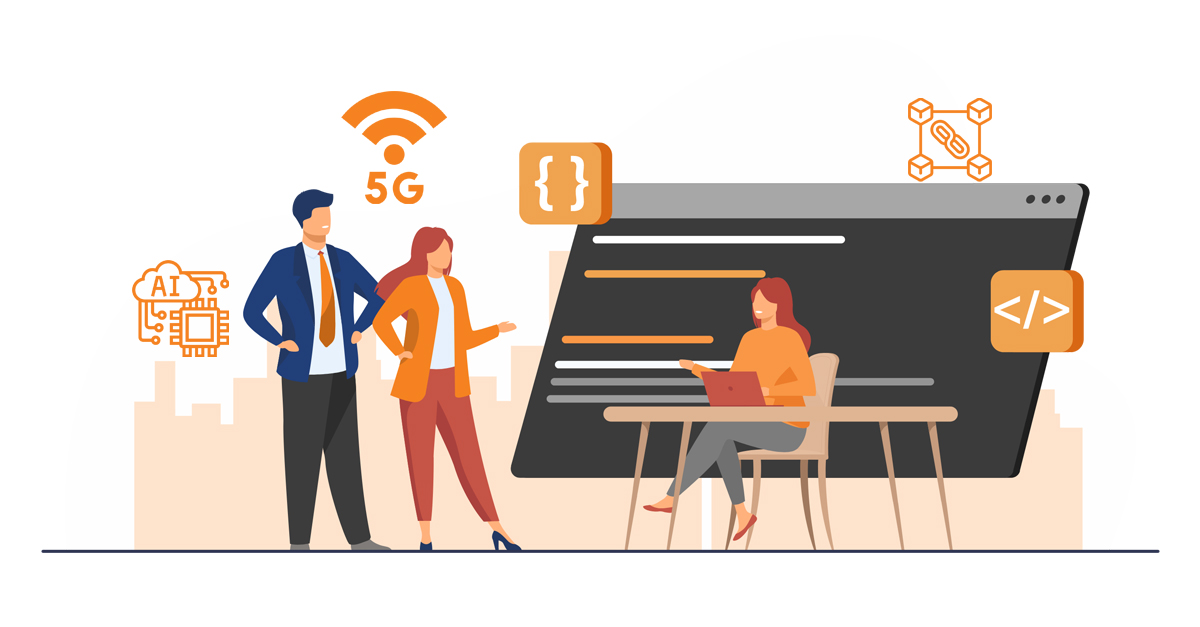Quick Summary: While businesses require different technologies, they should be aware of all the latest trends and constantly improvise to stand out fromf the market. Here are the 14 top technological developments that every business owner must look out for in 2023!
“To enhance their organization’s financial position during times of economic turbulence, CIOs and IT executives must look beyond cost savings to new forms of operational excellence while continuing to accelerate digital transformation,” said Frances Karamouzis, Distinguished VP Analyst at Gartner.
As we move into a new year-2023, organizations will encounter new challenges too. Several other threats to business success exist, from a rise in inflation to economic uncertainty.
According to Gartner, business spending on information technology is forecasted to increase up to $4.6 trillion as businesses accelerate digital transformation to overcome the effects of the pandemic and economic uncertainty.
But for these challenges, the organizations have several solutions at their, disposal. Technological advancements continue to bring convenience, efficiency, and better operations among various industries.
In the sections below, we will highlight and discuss the top 14 technological developments that every business owner must look into;
14 Top Technological Advancements in 2023
1. 5G Technology

This is the generation of 5G wireless technology. Just as 3G and 4G powered the internet to take over data-intensive tasks, 5G technology is expected to take the ability a few steps ahead. With 5G, users can work more efficiently and connect to several devices simultaneously.
The Importance of 5G
The benefits offered by 5G across industries are numerous. This tech would put the devices to better usage. Workers could easily benefit from better video quality and virtual and augmented reality enhancement. This tech also enables faster transactions, reliable automation, and better productivity.
2. Metaverse
Gartner defines a metaverse as a collaborative virtual 3D-shaped space birthed by physical and digital reality confluence. In simpler terms, it can also be Conceptualized as an immersive version of the internet. People now communicate through text and video, so the metaverse enables participation through a virtual environment.
By 2027, Gartner predicts that over 40% of large organizations worldwide will use a combination of Web3, AR cloud, and digital twins in metaverse-based projects aimed at increasing revenue.
Also, the metaverse would ultimately be device-and vendor independent. With a dedicated virtual economy, it would be enabled by digital currencies and non-fungible tokens (NFTs).
The Importance of Metaverse
Metaverse is vital on two levels, as other technologies. The first is that it can be deployed for company operations such as remote work and communications.
Secondly, it can benefit customers in terms of products and services.
For organizations to integrate metaverse in their offerings, platforms such as Decentraland and The Sandbox can explore metaverse in several ways.
3. SuperApps
According to Gartner, a superapp combines the features of an app, platform, and ecosystem. It has its functionalities and provides a platform for third parties to run their mini-apps.
“Although most examples of superapps are mobile apps, the concept can also be applied to desktop client applications, such as Microsoft Teams and Slack, with the key being that a superapp can consolidate and replace multiple apps for customer or employee use,” said Karamouzis.
For instance, WeChat- a Chinese platform, has functionalities such as digital currency, group payments, wealth management, flight purchases, and coupons.
The Importance of Superapps
Superapps would allow users to enjoy several digital services on a single platform conveniently. These apps are yet to become popular in the U.S.
As mentioned before, a superapp combines the functionalities of an app, platform, and ecosystem in one place; organizations need to start strategizing the same.
4. AI is taking over the world

AI is the machines’ ability to comprehend and make decisions. Being already proliferated in significant industries, this technology is expanding its application across industries. From online shopping to entertainment and communication, AI is used extensively in primary operations.
The basis of working for AI is based on predictive analysis, for which it uses machine learning to recognize patterns and draw meaningful conclusions from the same.
The Importance of AI
The current trend of AI revolves around Adaptive AI systems. This tech’s main aim is to continuously train and train models to learn within runtime based on new data and adapt quickly to the changes in real-world scenarios. They continuously use real-time feedback to change their learning and adjust their goals.
6. Moving forward with Blockchain Tech
Blockchain presents a centralized manner to store and establish trust between stakeholders operating on a similar ledger. The involvement of Blockchain would omit any involvement of third-party and would bring in transparency.
According to futurist Bernard Marr in Forbes, “The decentralization enabled by Blockchain will lead to new ways of transacting, communicating, and doing business and not just for humans. Machines, too, will benefit from the ability to carry out secure transactions between themselves.”
7. Progress in Web3
While discussing Blockchain, let’s remember Web3. In terms of upcoming trends in 2023, it is expected that Blockchain will advance significantly in 2023. For instance, at the moment, we are storing everything in the cloud, but if we decentralize the storage, the information will become safer, and you will have innovative ways to access the same.
A good read: The Advent Of Web 3.0, Remote-First Work Environments & Much More: In Conversation With Josh Loveridge
The Importance of Web3
The trend of Non-fungible tokens (NFTs) will become more practical this year. For instance, NFT tickets for a concert would provide you access to backstage experiences. NFTs are the keys used to interact with several digital products and services.
Investing in Blockchain tech would be fitting if your organization deals with similar products. Other companies should also be looking for blockchain usage within the management services.
8. Ensure Flexibility with Cloud
Cloud platforms enable organizations to store and analyze data off-site while enabling better flexibility & lower costs. Cloud services are highly secure, which allows the business to meet the ongoing challenge of protecting the consumer’s private data.
By 2027, Gartner predicts that more than 50% of enterprises will use industry cloud platforms to accelerate their business initiatives.
Why It’s Important
Industry cloud platforms are the next most significant trend for 2023. These platforms provide a combination of SaaS, platform as a service (PaaS), and infrastructure (IaaS) to enable industry-specific modular capabilities.
Enterprises may employ industry cloud platform bundled capabilities as building blocks to create distinctive business initiatives that provide agility, creativity, and a shorter time to market while avoiding lock-in.
9. Data Democratization
While data collecting and analysis have existed for a while, they have only been performed by a few data engineers who have received the necessary training.
Forrester predicts that data-centric organizations will make $1.8 trillion annually by the end of 2021. According to the Experian 2020 Data Democratization Report, 81% of surveyed business leaders said data democratization is a key initiative.
Data democratization enables professionals across businesses to do their analysis to get the insights they want swiftly.
Why It’s Important
Data democratization allows professionals with a wide range of knowledge and skill levels to swiftly access the information they need to make choices, rather than waiting days or weeks for data specialists to do it on their behalf. A few missed hours, days, or weeks in a highly competitive atmosphere might make the difference between winning and falling farther behind.
10. Increasingly Editable Technology
Soon, there will be a world wherein we can manipulate materials, plants, and humans. Thanks to nanotechnology, we can produce materials with new properties, such as water resistance and self-healing capabilities.
Although CRISPR-Cas9 has been around for a few years, gene editing technology will accelerate in 2023, giving us the increasing power to “edit nature” by modifying DNA.
Why It’s Important
Gene editing is similar to word processing in that you can remove certain words and replace them with others — but you can do it with genes.
Gene editing may rectify DNA mutations, address food allergies, improve crop health, and even modify human features such as eye and hair color.
11. Quantum Progress
There is now worldwide competition to build large-scale quantum computing.
Quantum computing, which harnesses subatomic particles to generate new ways of processing and storing information, is a technological breakthrough projected to deliver our computers that can operate a trillion times faster than the fastest regular processors.
Why It’s Important
The potential hazard of quantum computing is that it might render our existing encryption procedures obsolete. Any nation that develops quantum computing on a large scale could break the encryption of other nations, enterprises, security systems, and other systems.
This is a trend to keep an eye on in 2023, as countries such as the United States, United Kingdom, China, and Russia invest heavily in creating quantum computing technology.
12. RPA
Despite the name “robotic process automation” (RPA), this technology doesn’t always relate to real robots.
Instead, it refers to automated processes that can conduct tasks like executing transactions, processing data, or reacting to client contacts.
RPA tasks relieve human operators of this strain, allowing them to focus on higher-level issues.
Why It’s Critical
RPA enables firms to eliminate human error, save employee expenses, and deliver better customer service.
The usage of RPA may appear simple, but several aspects must be considered. Companies should set clear and attainable goals for what they want this technology to achieve.
When choosing how to use it, they should also bring officials from all departments, including and notably IT, to the table.
13. IoT
The network of interconnected objects, from home appliances to industrial gear, is known as the Internet of Things (IoT).
This technology is already being utilized, from smart homes to logistics to the electrical grid, to improve convenience and effectiveness for many objectives.
The U.S. National Security Council has stated its intentions to have standardized security labeling in place early next year. In fact, spending on IoT security measures may hit $6 billion during 2023 — a sizeable 300% increase from 2018.
Why It Matters
The likelihood that an organization will integrate IoT technology inside its operations is highest for businesses that deal primarily with physical things.
Businesses can, for instance, employ sensors on items received to relay data to a central database that maintains and analyses existing inventory and upcoming requirements.
14. Sustainability Solutions
Sustainable technology is being developed to ensure that all of the goods above may be used in an ecologically acceptable manner.
In the following video, a list of the top technological trends for 2023 incorporates sustainability as an added benefit.
Why It Matters
“Customers and investors are increasingly seeking green credentials, and we will see more of this in 2023,” Marr writes in the Forbes piece.
Blockchain technologies and data centers must both go green. Businesses must avoid wasting precious resources by running algorithms that don’t offer value and retaining data they don’t require.
Wrapping Up
Due to the rapid growth of technology, businesses may need help determining whether or not a specific tool is practical.
Businesses should think about either one of two strategies to reduce this uncertainty.
The first step is to pinpoint problem areas and look at technologies that could aid decision-making, efficiency, cybersecurity, training, or making the most of team members’ talents.
The alternative is to review the list above and consider potential applications for each technology inside your firm. With any strategy, it’s crucial to avoid using a solution just because it’s hip or the upcoming big thing.
The secret to effectively utilizing technology in a corporate setting is to be sure it will advance organizational goals.
Summary
Kickstart Your Project With Us!
Popular Posts
CONTACT US
Let's Build Your Agile Team.
Experience Netsmartz for 40 hours - No Cost, No Obligation.
Connect With Us Today!
Please fill out the form or send us an email to







